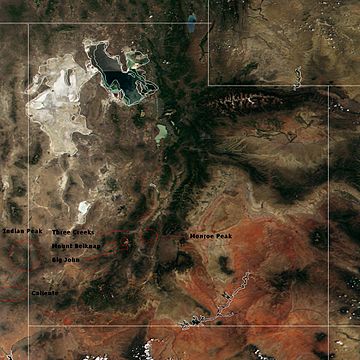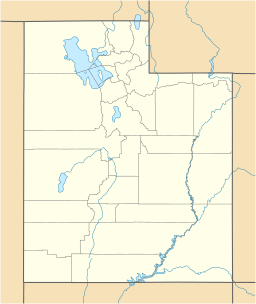Marysvale volcanic field facts for kids
Quick facts for kids Marysvale volcanic field |
|
|---|---|

Indian Peak caldera complex, and Caliente, Three Creeks, Mount Belknap, Big John and Monroe Peak calderas.
|
|
| Highest point | |
| Geography | |
| Location | Utah, United States |
| Geology | |
| Age of rock | Middle Cenozoic |
| Mountain type | Volcanic field |
The Marysvale volcanic field is a huge area in southwestern Utah, United States, where many volcanoes have erupted over millions of years. It's one of the biggest volcanic areas in the western United States.
This special place sits right where two major land regions meet: the Colorado Plateau and the Great Basin. It's like a border zone between them.
Most of the rocks here were formed from volcanoes between about 32 and 22 million years ago. These are called "igneous rocks" because they came from melted rock (magma). More recently, from about 23 million years ago until today, there have been different types of eruptions. These later eruptions created rocks that are either dark, runny basalt or light-colored, thick rhyolite.
The Marysvale volcanic field has many different kinds of volcanic shapes. You can find tall, cone-shaped stratovolcanoes, huge bowl-shaped calderas (which are collapsed volcano tops), dome-shaped lava domes, and smaller, cone-shaped hills called cinder cones.
Contents
Marysvale Volcanic Field
How This Volcanic Area Formed
The Marysvale volcanic field is an example of "intraplate volcanism." This means the volcanoes formed in the middle of a tectonic plate, not at its edges where plates usually crash or pull apart.
Scientists believe the older volcanoes here were linked to a process called "subduction." This is when one of Earth's huge tectonic plates (the Farallon plate) slid underneath another plate. This movement caused rocks to melt and rise, forming volcanoes.
The newer volcanoes, especially those that made basalt, are thought to be related to the "Basin and Range extension." This is when the Earth's crust in this region started to stretch and pull apart. As the crust thinned, magma could more easily rise to the surface and erupt.
Giant Volcano Collapses: Calderas
One of the most interesting features of the Marysvale volcanic field are its calderas. A caldera is a large, bowl-shaped hollow that forms when the ground collapses after a huge volcanic eruption empties the magma chamber below. It's like a giant crater.
Here are some of the notable calderas found in the Marysvale volcanic field:
| Name | Size (approx.) | Location | Age (millions of years ago) |
|---|---|---|---|
| Monroe Peak Caldera | 20 x 16 km | 38°29′00″N 112°03′30″W / 38.483333°N 112.058333°W | 23 Ma |
| Big John Caldera | 10 x 6 km | 38°19′06″N 112°23′00″W / 38.318225°N 112.383333°W | 24 Ma |
| Mount Belknap Caldera | 17 x 13 km | 38°26′51″N 112°30′00″W / 38.4475°N 112.5°W | 19 Ma |
See also
 In Spanish: Campo volcánico de Marysvale para niños
In Spanish: Campo volcánico de Marysvale para niños


